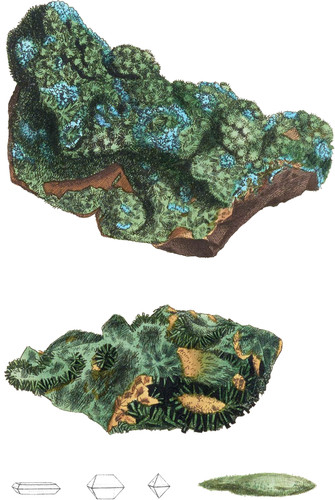 Enlarge
Enlarge
Exotic Mineralogy
Muriate of Copper
- Syn.
- Cuivre muriaté. Haüy, 3.560.
- Copper mineralized by muriatic acid. Kirw. 2. 149.
- Kupfer sand. Karsten Mineral Tabellen. 46.
This noticed in the sand of Peru in the form of a green powder, and is said to have been first brought from thence by Dombey. The specimens I have had given me from time to time have been in small grains, the largest of which I have been able to discover to be rectangular octaëdral crystals, and some, as it were, placed by the sides of each other. Some of the elongated ones seem to be more or less truncated at their apex and opposite, thus making a flattish hexaëdral column, with diedral summits. I found one truncated upon one of the pyramidal edges. Two of the planes of the octaëdron meet at the summit, at an angle of 75°, 45′. and the other two at an angle of 67°, 15′.
The upper figures are taken from specimens presented by Professor Davy to the late Hon, Mr. Greville, and are now in the collection of the British Museum, where I have the pleasure, through the favour of the Trustees, to renovate the remembrance of my lost friend. They are from Peru, It is rare to find such fine specimens, and an high satisfaction to see the crystals on the matrix, which is chiefly silicious. They appear to belong to the same formation as the granular variety below, and show the prismatic form more easily, by their adhering to one end, a little analogous to the arseniates of copper. See Brit. Min. tab. 168, 169, 170. Their surface is smooth, bright or brilliant; fracture foliated parallel to the obtuse end of the prism; colour of the crystals a fair green, being neither blue nor yellow; when broken they appear lighter and more opaque, as if diluted with white; easily powdered by pressure with the linger nail, which discovers the lighter colour to proceed from powdered particles.
The crystals on the uppermost figure are diverging in stellæ of partly-formed hexaëdral prisms, terminated by diedral pyramids, and are accompanied by silical oxide of copper, or chrysocolle. Thrown on flaming coals the flame becomes green and blue. Nitric acid dissolves it without effervescence, forming a green solution. Spec. Grav. 3.570.
| Oxide of Copper | 73.0 |
| Muriatic Acid | 10.1 |
| Water | 16.9 |
| 100.0 |
Since writing the above, we have been favoured, by the accurate Mr. John Davy, with the result of his analysis of this muriate of copper. It agrees with the artificial submuriate.
| Analysis. | ||
|---|---|---|
| Brown Oxide of Copper | 73.2 | |
| Real Muriatic Acid | 16.4 | |
| Water | 10.4 | |
| 100.0 | ||
It is in consequence of the development of the true nature of the muriatic acid by Professor Davy, that the proportions of muriatic acid and water are found to be so different from what Klaproth states them.

